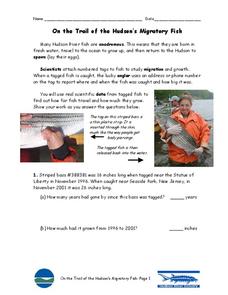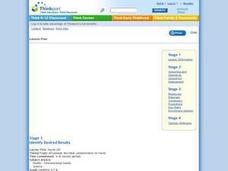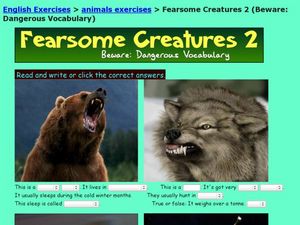Curated OER
On the Trail of the Hudson's Migratory Fish
Ever wonder how scientists track fish underwater? Your class can learn how with this informative worksheet. First, they will read a paragraph about androgynous fish, tagging, and data analysis. Then, your scientists must answer five...
MathMovesU
Practice: Measuring Angles and Using a Protractor and More!
Four fabulous worksheets are included in this resource, all having to do with the measurement of angles. On the first, anglers will use a protractor to determine the degrees of 10 different angles. An arc is drawn on each. On the second,...
Curated OER
The Deep
In this deep ocean worksheet, students answer twenty questions after watching a video about the species that live in the deep ocean. Topics include jelly fish, hatchet fish, anglers, tubeworms, sea urchins, and plants that grow in deep...
Helping with Math
Angles: Supplementary, Corresponding & Alternate (2 of 2)
In the second of two similar worksheets, anglers compute missing angles when given an alternate, supplementary, or complementary value. There are six problems to solve, but each of them requires two to four solutions. This is a nice...
University of Southern California
What's the Catch?
There must be a catch! A comprehensive lesson looks at ocean fishing concerns through a set of five hands-on activities. Learners become aware of the risks of seafood contamination and factors that have affected the ocean environment.
Curated OER
Strong Verbs
Add interest to your class's writing by having them focus on strong verbs. Using this worksheet, first have them identify all of the main verbs in each sentence. Then, have them rewrite each sentence using a stronger verb. Practice often...
American Museum of Natural History
Journey to Deep Sea Vents
Take a deep dive into oceanography. The online interactive allows for learners to board a submersible to dive to the bottom of the ocean to investigate sea vents. On the way down, individuals see different marine life at different...
Curated OER
On the Trail of the Hudson's Migratory Fish
Using data related to the fish in the Hudson River area, learners calculate distance, elapsed time, and growth. They learn about migratory fish, the life cycle of a fish, analyze a map, and answer questions.
Curated OER
The Hudson's Ups and Downs
Even rivers have tides. Older elementary schoolers will discuss the Hudson River and how weather, water craft, and the ocean cause tidal fluctuation. They will examine a series of line graphs that depict tidal fluctuation, then analyze...
Curated OER
The Hudson's Ups and Downs
Fifth graders practice interpreting line graphs of the Hudson River water levels to assess the tides and tidal cycles in the estuary. They explore how weather can affect water levels and tides and observe that high tides and low tides...
Curated OER
Fishing
Students explore the techniques and basic needs of the fisherman. In this fishing lesson, students view a demonstration of the use of fishing equipment. Students research Iowa farm ponds and design a class mural from their information. ...
Curated OER
Stream Table
Students explore channelization, riparian habitats and soil erosion to find out about the aquatic habitats in Iowa. In this aquatic habitats lesson, students define important terms and read an article about pollution. Students complete...
Curated OER
Mock Fly-Tying
Students make their own fly-fishing flies. In this aquatic macroinvertebrates lesson, students look at images of different species of aquatic macroinvertebrates. Students compare the similarities and differences among the species. ...
Curated OER
Hands Off
Middle schoolers perform a handwashing experiment to see if a difference can be detected in the number and types of microbes on our hands after various types of cleaning. They will also demonstrate that they have learned the whys and...
Curated OER
N, B, and T: Pollutants Three
Young scholars explore nutrient, bacterial, and toxic surface water pollution. They identify the amount of water they use each day and summarize the kinds of substances that cause water pollution. They predict what will happen in water...
Curated OER
Match the Hatch
Students learn how to flyfish and learn that flyfishing plays an important role in protecting, and restoring coldwater fisheries. In this flyfishing lesson plan, students learn the art of flyfishing and learn about the natural feeding...
Curated OER
Fearsome Creatures 2
In this fearsome creatures worksheet, students choose the correct words to fill in the blanks to sentences about dangerous animals. Students complete this for 10 animals.
Curated OER
Ask An Expert
Young scholars invite community members to visit the classroom and interview them about water in the community. Students prepare for, conduct, and follow up an interview and record their responses in their Water Journals.
Curated OER
Trout Fishing in the Connoquenessing Watershed
Students create a tri-fold brochure to be used with their local Tourism Bureau that includes information and photos of local streams and lakes and trout fishing areas. Students write a description of the area and include a map of the...
Curated OER
Make Words: Muskellunge
In this language arts and science worksheet, students examine a picture of a muskellunge (a type of fish). Students read the informative paragraph, then build as many words as possible from the letters in its name.





















